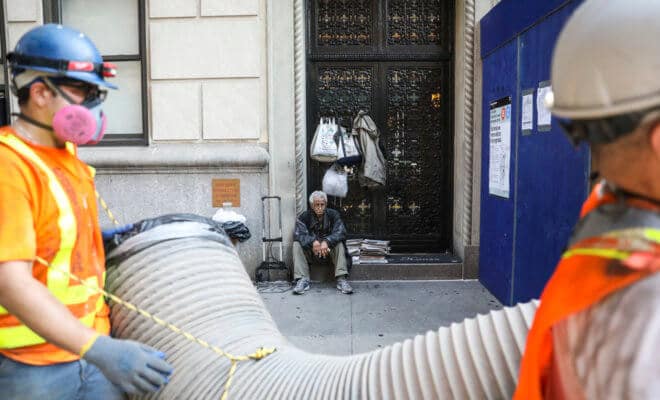Life
Vendor Stays as Subway Skips His Stop

Ram Badan Singh, who sells newspapers, in New York.
Photo Credit: Marian Carrasquero/The New York Times
One morning in early June, men in orange vests boarded up the subway entrances at 86th Street and Central Park West and posted signs: “Extensive renovation in progress.”
Veteran news purveyor that he is, Ram Badan Singh eyed the message skeptically and suggested this rewrite: “Extensive misuse of money in progress.”
The closing of three Upper West Side stations — at 72nd, 86th and 110th streets — for several months of work has meant inconvenience and annoyance for people who live near the park. But for Singh, the subject of an April profile in The New York Times, the project is a threat to his livelihood.
Singh, who turned 81 this month, is one of only a handful of independent newspaper hawkers still plying his trade on the streets of New York. He has sold papers on the sidewalk outside the 86th Street station every night and morning for 36 years with no newsstand or shelter, and rarely a day off. Bundled in several layers of clothing, he has persisted through blizzards, hurricanes and even the summers that turn the Upper West Side into a ghost town; his only concession to the recent heat has been to shed his wool hat and scarf.
But this latest disruption is hitting where it hurts: In the seven weeks since the station closed, diverting the usual flow of commuters, he estimates he has forfeited more than $1,000 in sales. On Sundays, he used to finish with five or six of his 135 papers unsold; now he is left with about 35.
Luckily, Singh has a New Yorker’s seen-it-all unflappability and a deep bench of faithful customers. Before the closings, one of them asked the Metropolitan Transportation Authority to compensate the vendor for lost business; the agency said it couldn’t offer money but would try to find some creative way to help. This past week, the MTA said the most it had been able to do was to encourage the workers in orange to buy papers. (Singh said that none have.)
So the customers have taken charge. Tira Grey, who produces hedge-fund conferences and lives down the street, started a GoFundMe campaign to raise enough money to tide him through to the station’s reopening in October.
Grey began buying from him in 1999, when she was booking guests for “60 Minutes” and needed to comb the papers every day for story ideas. She moved downtown four years later, and when she returned to the neighborhood in 2016, she was astonished to find Singh still in his spot.
“I texted all my friends,” she said. “When people ask why I like living on the Upper West Side, it’s my go-to story: 13 years later, here’s the same newspaper seller on the same corner, looking like he hasn’t aged a bit.”
Her fundraising effort has collected more than $9,600 from 52 donors. A contributor in the Sunnyside neighborhood of the Queens borough, in New York, express-mailed $1,000 in cash to The Times, along with a letter that proclaimed Singh “an extraordinary human being.” It was signed: “Ho, Ho, Ho. Yes Virginia, there is a Santa Claus.”
Singh was a civil engineer in his native India. After coming to New York in 1980, he tried a number of jobs before settling into his solo act outside the subway.
Even with the station shuttered, he won’t move to a different spot; this is where his regulars know where to find him. Over the years, he has jealously guarded the corner against interlopers: He outlasted the hawkers of free papers who appeared a decade ago. When a rival salesman showed up one night on an opposite corner, Singh and his customers stared him down until the man gave up a few days later. (Once, back in India, Singh shot an intruding cobra, but that’s another story.)
Shortly before the subway station closed June 4, Singh was thrown a fresh curveball: The Times turned over its retail distribution in Manhattan to another company, National Distribution Alliance. Singh, who buys his papers from The Times and other publishers, has had to acclimate to new delivery times and payment methods.
The Times article brought him a flurry of celebrity. A married couple visiting the city from South Africa made a special trip uptown to be photographed with him; a young woman from Japan sought him out and handed him $100. Readers from around the world praised him on social media — though Singh seemed only vaguely aware of the stir. He has no phone or computer. He lives alone and reads the news only in print.
His longer-term fans continue to trickle by every morning. On Thursday, three of them arrived with some belated birthday cake, a New York City-branded towel and a new umbrella. Singh was cheered, but still mourning the recent death of a loyal customer.
“You see this man for so many years, and then suddenly he is gone,” he said. “I will miss him.”
© 2018 New York Times News Service

You must be logged in to post a comment Login